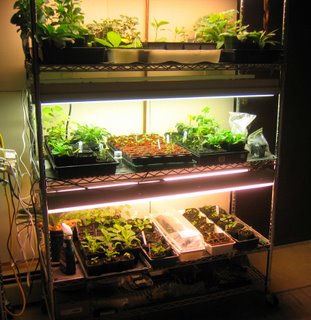The dismal year in the vegetable garden (probably because I neglected to water it enough) and a renewed desire to eat tasty greens has caused me to return to basement gardening. I can easily grow enough sweet, tender lettuce for sandwiches in the basement. The time investment is minimal -- I remember to water the plants whenever I do laundry. Also, there are no bugs (other than the odd spider) and the temperature is pretty comfortable to work in. So far, my two buttercrunch seedlings haven't grown very large. Unfortunately for them, I got hungry. I'm thinking that I need to start more lettuce, ideally in a variety of shapes and colors. What I really need is enter a lottery to win a greenhouse. Anybody heard of such a thing? At least it sounds better than the legion's "meat draw".
Here are the two
Jack Pine seedlings, destined to become my first bonsai conifers (the white bottle is just to demonstrate their size):

They were started at the same time (Feb/09) despite the dissimilar appearance. These were part of a
mini bonsai kit I got last Christmas. These trees really should have some sort of change in climate for their winter. Perhaps I'll put them out in the partially heated garage, but in bigger pots so they don't totally dry out.

Continuin

g on with the fall's indoor gardening kick, here is my recent shipment of
Kaffir lime seeds. I ordered these on ebay and they arrived with these handy instructions. I got tired of reading my Indian cookbooks and skipping recipes that called for the leaves of this plant. They give a limey flavour and are used like bay leaves. The green fruits are not edible.
 Kaffir lime (Citrus hystrix) seeds planted
Kaffir lime (Citrus hystrix) seeds planted, keeping company with my herbs:

Finally, the most exciting indoor garden news is a purchase of a miracle fruit plant. Have you
seen these berries on TV? They are like LSD for your tastebuds. Miracle fruit parties are popping up everywhere. RLM mused that it would be really cool to have one of these plants, though I replied that plants native to Ghana probably wouldn't thrive here. After a quick internet search the other night though, I found a supplier in Montreal and ordered a plant for about $35 including shipping. Canada post sent me a tracking information email today, so I hope to get my plant soon. It has a few particular needs, like acid soil, but that's not too hard to manage. I'm so excited. I'll post as soon as I get my new plant.













































